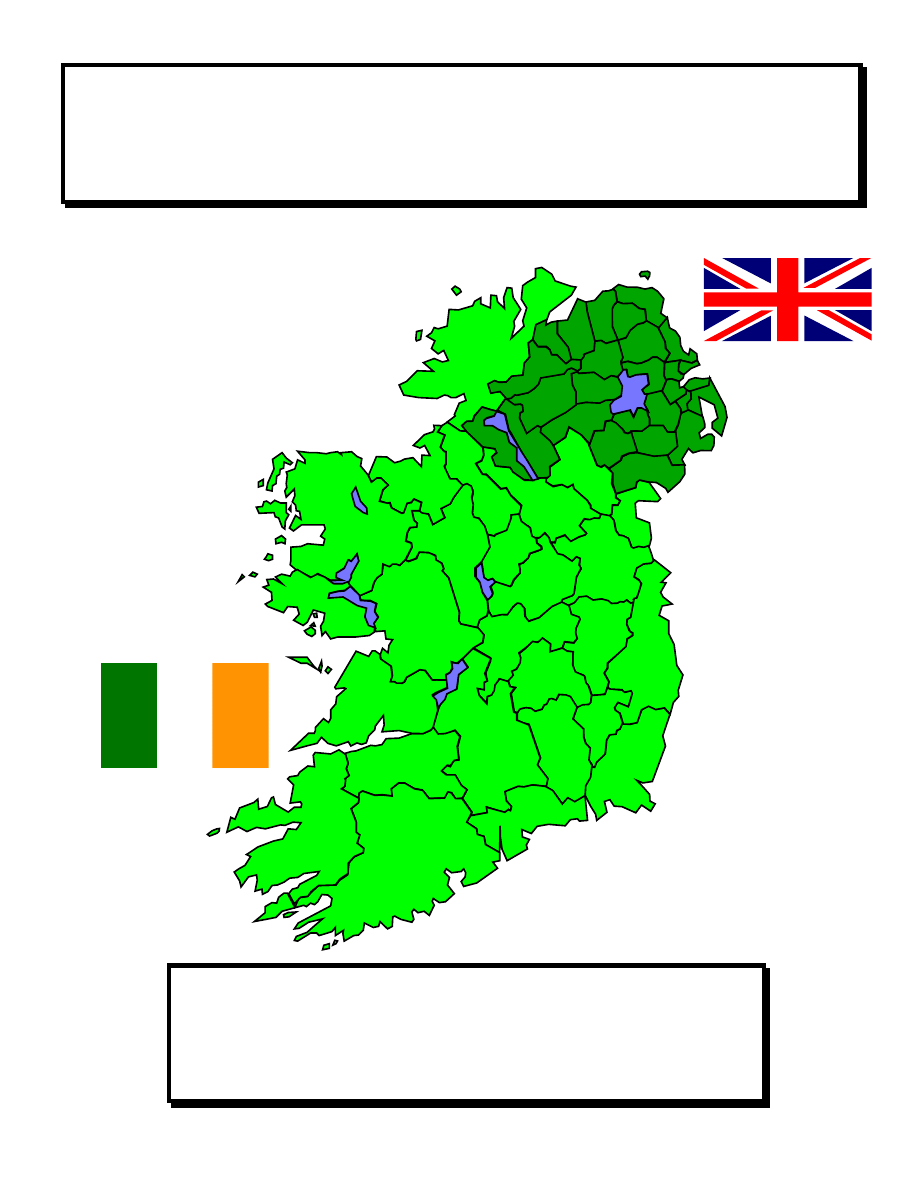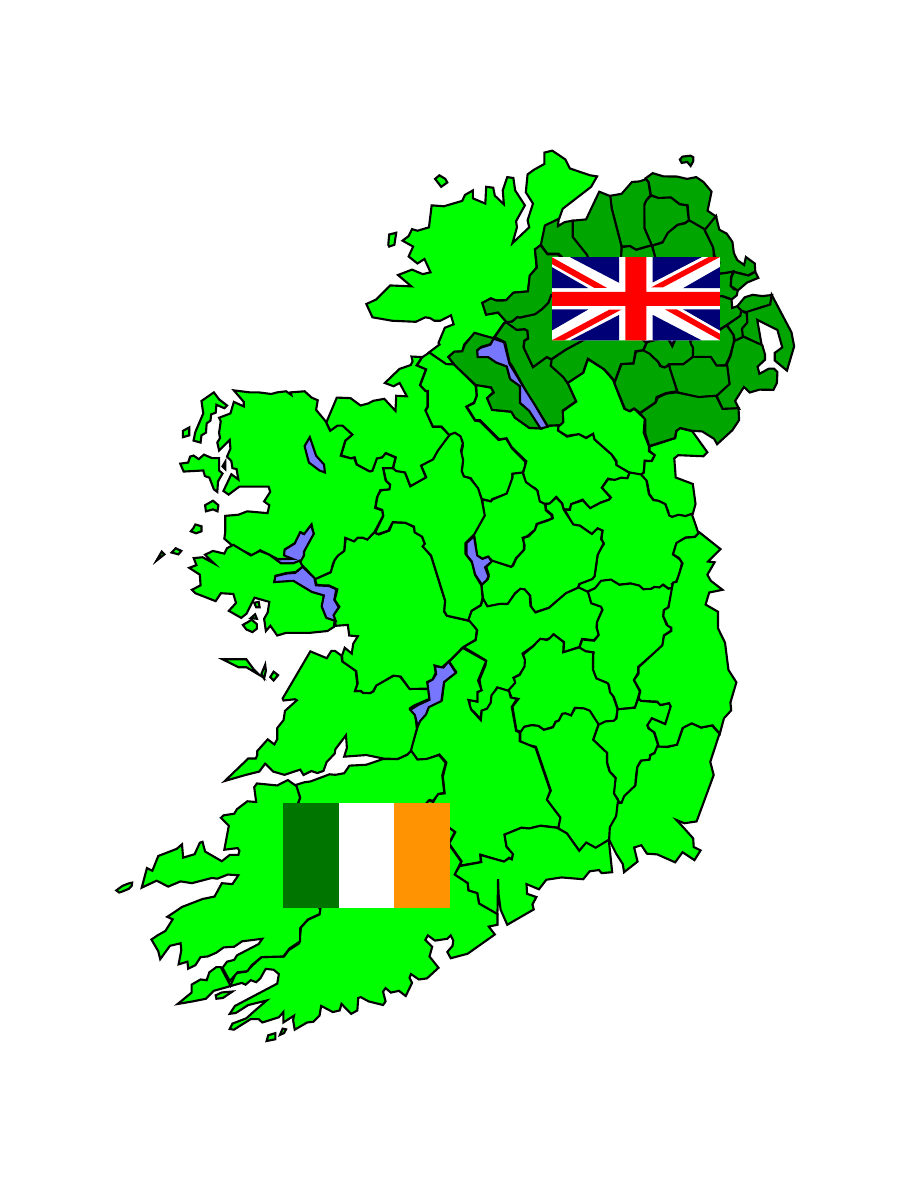
Divided Ireland
by Taro Fruhwirth, 5HBa
Mag. Schaludek-Paletschek
CORRECTED VERSION

Divided Ireland (Corrected Version) 18.02.1997
Taro Fruhwirth, 5HBa
page 2 of 2
TABLE OF CONTENTS
The Beginning of the Conflict ................................................ 3
The Home Rule Controversy .................................................. 4
The Republic of Ireland .......................................................... 4
The Civil Rights of the Irish in Northern Ireland.................... 5
The Irish Economy.................................................................. 5
Constitutional Controversies................................................... 6
The Anglo-Irish Agreement .................................................... 6

Divided Ireland (Corrected Version) 18.02.1997
Taro Fruhwirth, 5HBa
page 3 of 3
DIVIDED IRELAND
by Taro Fruhwirth, 5HBa
My speech is about the history of the Irish and English people and the conflict concerning the
area called Northern Ireland.
THE BEGINNING OF THE CONFLICT
The first time mankind arrived on the island of Ireland was about 200 years before Christ. In
the year 432, St. Patrick came to Ireland, initiating a “Golden Age“ of cultural and spiritual
development.
But in the year 1169, this era came to an end and a time of pain and agony began. This was the
year when the Anglo-Normans, who were the forefathers of the English nation, started to
invade Ireland and finally controlled most of the country. This was the origin of the national-
based conflict. England tried to conquer the whole land and to extinguish the Irish nation, but
it never achieved that target. This caused very much hatred and hostility against England in
the minds of the Irish people.
But what made peace between the two countries nearly impossible was the conflict between
the cultures and religions. This was also the reason why a fusion with England became so
inconceivable. The planned reformation of the Irish population was not just unsuccessful, but
it also created a big gulf between the Catholic Ireland and the Protestant England.
When two chieftains of Ulster, which is the northern part of Ireland, were defeated and
departed from England they started a plantation of Protestant settlers in the North of Ireland.
This land is now a part of the United Kingdom, called Northern Ireland.

Divided Ireland (Corrected Version) 18.02.1997
Taro Fruhwirth, 5HBa
page 4 of 4
THE HOME RULE CONTROVERSY
In the year 1800, the United Kingdom was created, consisting of Great Britain and Ireland.
This led to a never-ending movement to repeal the union between the two isles.
The Great Famine in 1846 changed the political scenery. It confirmed Irish fears about the
incapacity of the British administration in handling Irish needs. But also many English
politicians saw that the situation needed to be changed.
This was the beginning of the idea of Home Rule. In 1886, the Liberal Prime Minister
Gladstone introduced the first Home Rule bill. This bill gave certain powers to a Dublin
parliament. But the first, and later also the second, Home Rule bill were rejected. The first
Home Rule bill was rejected in the House of Commons, the second in the House of Lords.
The third and last attempt to establish Home Rule was prevented by the illegal Ulster
Volunteer Force until the First World War broke out. The UVF is still active in Northern
Ireland.
THE REPUBLIC OF IRELAND
After the First World War, a radical republican party called Sinn Féin (“Ourselves alone“ in
Gaelic) won the general election, but instead of taking their seats, they established an
alternative parliament. A year later, in the year 1919, the War of Independence began. On the
side of the Irish people, the Irish Republican Army was founded to fight the British troops.
The war ended in 1921 with a treaty that partitioned the isle. 6 counties of Ulster remained
with the United Kingdom, the rest of the 26 counties formed the Republic of Ireland in 1922.
But this solution satisfied neither of the two sides, it was only seen as a temporary measure.
The partition was based on the religious distribution of the population.
Except for the following rumours between pro and anti-Treaty forces that lasted a year, the
Republic of Ireland stayed mainly peaceful until today. But in Northern Ireland the conflict
between Irish and English people held on and has not ended yet. An armed police force called
the Royal Ulster Constabulary and the British army were sent to Ireland to establish peace and
order. But instead of this, they were fighting a war against the IRA, which is still going on
now.

Divided Ireland (Corrected Version) 18.02.1997
Taro Fruhwirth, 5HBa
page 5 of 5
THE CIVIL RIGHTS OF THE IRISH IN NORTHERN IRELAND
In the beginning of the existence of Northern Ireland, the Irish and Catholic population of this
area was not very happy with the new state. They voted mainly for Nationalist politicians. But
the British and Protestant population was about two-thirds of the whole state. So the Unionists
that received the majority of the vote from the Protestant population were the ruling party.
Many Unionists felt that the Catholic disloyalty to the new state justified discrimination
against them. The electoral system with its principle of winner-take-all played a large part in
the discrimination against the Catholics.
Rising living standards that came with the years made people on both sides more tolerant to
each other. This resulted in the forming of the Northern Ireland Civil Rights Association in
1967. This Association demanded an electoral reform and fair housing allocation. Many
marches were held for these changes and the demands were met a year later. But the marches
were often attacked by extremist Protestants.
THE IRISH ECONOMY
1920 - 1929 : The partition from the highly industrial Northern Ireland resulted in a high
degree of agricultural industry. Therefore the living standard was very low and
many people emigrated. But eventually the beginning of rural electrification
was a major success.
1930 - 1959 : In this period Ireland was not able to increase its industrial efforts because of
another war with Britain just economic and because of Ireland’s isolation in the
Second World War. In the 1950’s, the emigration rate was at its highest point
ever and the population was declining.
1960 - 1979 : In this time the economy recovered and Ireland was rapidly industrialising. The
consequences were rising living standards and population levels.
1980 - 1989 : This period brought recession back to Ireland and the emigration of people
started again.

Divided Ireland (Corrected Version) 18.02.1997
Taro Fruhwirth, 5HBa
page 6 of 6
CONSTITUTIONAL CONTROVERSIES
Eamon De Valera was one of the most important persons in the history of the Republic of
Ireland. He founded a new party, called Fianna Fáil, that is today one of the largest parties in
Ireland. He created a new constitution in 1937 and made a Republic out of Ireland, though this
was not officially recognised by Britain until 1949. His constitution is still in force today. But
a number of articles have caused considerable controversy.
Article 2. ( Territory )
The national territory consists of the whole
island of Ireland, its islands and the
territorial seas.
This article is still in force. It is seen by many
people as encouraging violence against British
administration in Northern Ireland.
Article 41. ( Family Rights )
3.2. No law shall be enacted providing for the
grant of a dissolution of marriage.
This article is also still in force. There was a
referendum in 1986 to remove the prohibition
of divorce. But this referendum has failed.
THE ANGLO-IRISH AGREEMENT
In 1985, Garret Fitzgerald and Margaret Thatcher signed an important agreement between the
United Kingdom and the Republic of Ireland.
In this agreement the British Government “recognises the need to acknowledge the rights of
the two major traditions“. These traditions are the tradition of the unionists, who want to unify
Ireland with Great Britain, and the tradition of “those who aspire to a sovereign united Ireland
achieved by peaceful means and through agreement.“

Divided Ireland (Corrected Version) 18.02.1997
Taro Fruhwirth, 5HBa
page 7 of 7
The British Government also committed itself to abandon discrimination and intolerance.
Special notice should be given to the next sentence that is written in the agreement.
“If a majority of the people of Northern Ireland give their consent to Irish unity, the British
Government commit themselves to introduce and support in the Westminster parliament,
legislation to give effect to this.“
Added to this, the British Government agrees to establish an Intergovernmental Conference
concerned with Northern Ireland and with relations between the two parts of the island. And
this conference imposes both governments to make efforts to resolve any differences in the
interests of promoting peace and stability.
The first meeting of this conference discussed the policies of the RUC and the British armed
forces.
The purpose of this agreement is that the nationalists should change their opinion about the
structure of government, the security forces and the judicial system in Northern Ireland.
Finally I would like to tell you (to end with) the last sentence of a Fine Gael party leaflet about
the Anglo-Irish Agreement.
“Of course it is always easier to do nothing, in the hope of avoiding blame for anything that
may go wrong, but such an attitude would be totally irresponsible in the face of the tragedy of
Northern Ireland.“

TABLE OF CONTENTS
The Beginning of the Conflict
The Home Rule Controversy
The Republic of Ireland
The Civil Rights of the Irish in Northern Ireland
The Irish Economy
Constitutional Controversies
The Anglo-Irish Agreement
VOCABULARY
agony Schmerz,
Leid
to aspire
streben
bill Gesetzesentwurf
controversy Streitfrage
electoral system
Wahlsystem
to extinct
ausrotten
hatred Hass
hostility Feindschaft
partition Teilung
party Partei
to plant
hier: ansiedeln

Divided Ireland (Corrected Version) 18.02.1997
Taro Fruhwirth, 5HBa
page 9 of 9

Divided Ireland (Corrected Version) 18.02.1997
Taro Fruhwirth, 5HBa
page 10 of 10
200 B.C. Celtic speaking people arrive in Ireland
432
St. Patrick comes to Ireland
1169
The Anglo-Normans invade Ireland
(Origin of English-Irish conflict)
1536
English start Reformation in Ireland
(Origin of religious conflict)
1607
Protestant settlers are planted in Ulster
(Origin of Ulster conflict)
1846
The Great Famine
1886
First Home Rule bill is rejected
1893
Second Home Rule bill is rejected
1912
UVF formed to resist Third Home Rule
1918
Sinn Féin party wins general election
1919 War
of
Independence
1921
End of the war
1937
Republic of Ireland is founded
1967
N.I. Civil Rights Association is founded

Divided Ireland (Corrected Version) 18.02.1997
Taro Fruhwirth, 5HBa
page 11 of 11
“DIVIDED
IRELAND“
12.12.1996
by Taro Fruhwirth, 5HBa
TABLE OF CONTENTS
The Beginning of the Conflict
The Home Rule Controversy
The Republic of Ireland
The Civil Rights of the Irish in Northern Ireland
The Irish Economy
Constitutional Controversies
The Anglo-Irish Agreement
TIME TABLE
200 B.C.
Celtic speaking people arrive in Ireland
432
St. Patrick comes to Ireland
1169
The Anglo-Normans invade Ireland
(Origin of English-Irish conflict)
1536
English start Reformation in Ireland
(Origin of religious conflict)
1607
Protestant settlers are planted in Ulster
(Origin of Ulster conflict)
1846
The Great Famine
1886
First Home Rule bill is rejected
1893
Second Home Rule bill is rejected
1912
UVF formed to resist Third Home Rule
1918
Sinn Féin party wins general election
1919
War of Independence
1921
End of the war
1937
Republic of Ireland is founded
1967
N.I. Civil Rights Association is founded
VOCABULARY
agony Schmerz,
Leid
to aspire
streben
bill Gesetzesentwurf
controversy Streitfrage
electoral system
Wahlsystem
to extinct
ausrotten
hatred Hass
hostility Feindschaft
partition Teilung
party Partei
to plant
hier: ansiedeln
Wyszukiwarka
Podobne podstrony:
6038
6038
6038
6038
6038
6038
39 Р 6038А коор
więcej podobnych podstron